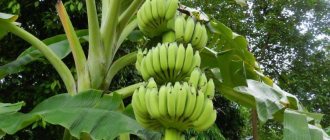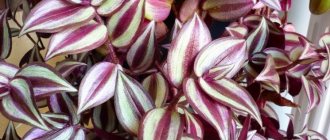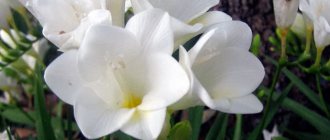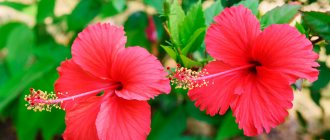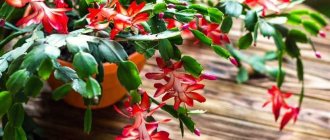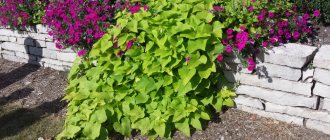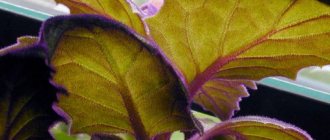The spectacular Haworthia of the Xanthorrhoeaceae family, subfamily Asphodelaceae, is often cultivated as a house plant. Dwarf and miniature succulents prefer well-lit window sills, terraces or balconies, but do not tolerate heat.
The flower received its name in honor of Adrian Haworth, an English botanist, which determined its place in the classification.
Botanical description with photo
Haworthia (lat. Haworthia) does not have colorful leaves and is not rich in flower buds, but the wide range of leaf shapes of the graceful succulent has invariably attracted the attention of gardeners for many years.
Botanical characteristics of the crop:
- The leaves are fleshy, dark green in color, in some species they are covered with white, warty tubercles, the edges are smooth, with “cilia”, denticles or long spines.
- The rosette is basal, of linear and pointed sheaths, which, depending on the variety, are widely spaced or tightly fitted to each other.
- The peduncles are long, it is recommended to cut them off to avoid depletion of the plant.
- The buds are small, white, almost identical in most species, and rarely appear at home.
- Root system - there are 3 types. The first ones are thick, increase in size when moistened, and disappear into the ground on their own when dry. The latter are fleshy and create an extensive network. Still others live in the above-ground part and pull the plant into the ground until the leaves are alive when the dried ones fall off.
Reviews from flower growers about growing Haworthia
Haworthia was given to me in the summer at work. I carried it home in the hot sun and its fleshy leaves literally shone through, I saw every vein inside and it seemed that I could even hear the movement of juice through the cells. Shimmers and the charm of beauty were associated with a soap bubble. So I called Haworthia “soap bubble”. Caring for this succulent is incredibly simple. The main thing is to always remember to water and be attentive to changes in the appearance of the leaves. If the plant does not have enough fertilizer or light, the leaves lose their brightness, density, Haworthia does not look very good... This has already happened to us. I love flowers and growing them is just a great pleasure. Now I regret that I didn’t take more intermediate photos. I share what I have. Above you saw a photo of the first three years of Haworthia’s life. In her fifth year, she had grown significantly and turned into a whole family.
Canary
https://irecommend.ru/content/iz-mylnogo-puzyrika-v-rossyp-izumrudov-istoriya-moei-shikarnoi-khavortii
A few years ago, my husband gave me flowers on March 8th. And not a bouquet, but live ones, in a pot. There were calla lilies in a beautiful package. And as a bonus they came with a tiny pot of Haworthia Pearl. She was then still just a tiny little girl. What did I learn about my Khavrosh? The plant belongs to the succulent family, which also includes aloe and cacti. This plant is named after the English botanist Adrian Haworth. The plant is native to South-West and South Africa. Moreover, in the natural environment, this plant hides in cool, shady places - under bushes, in grass, etc. My plant is called Haworthia margaritifera - pearl Haworthia, a perennial succulent from South Africa that forms a rosette of leaves. From the side it resembles the tentacles of an octopus, and from above it resembles a star with many rays. This is the beauty I grew up with over the course of several years. And she even gave birth.
Kity
https://otzovik.com/review_629995.html
I got a haworthia about four years ago, a friend gave me a cutting. I planted the plant in a pot that was relatively large for it at that time, and it took root without any problems. During this time, I never replanted it and never fed it with fertilizers. Every spring I take my haworthia outside, where it lives until late autumn. In summer it produces arrows with small white flowers. I water it almost every day in the summer, and in winter watering is kept to a minimum, about once a month. It grows quickly and looks impressive.
Krisha
https://otzovik.com/review_826932.html
I only recently learned that haworthia grows on my windowsill. Because this unpretentious plant was given to me at the institute during a community cleanup. So this cute bush lived, looking like a mixture of cactus and aloe - without a name or surname. But not so long ago I found out that my plant’s name is Haworthia, that it is a succulent, and that it needs to be watered infrequently and a little. And I started doing everything according to the rules... and so what? My haworthia began to dry out around the edges - an unpleasant sight. I thought that maybe it was the fact that we had changed the windows or the lighting was not right - the time of year was taking its toll... until one fine moment I came across a similar story on the Internet, where a girl told me that this flower had also dried up for her, when she decided to take care of him according to the rules. Now I don’t listen to anyone: the soil has dried up - I water it, and quite abundantly. About once every couple of days. And what? Haworthia began to come to life, the number of dry tops decreased noticeably, only a couple remained. In general, I realized that rules are good, but you also need to think with your own head. And recently I replanted my flower - it took up the entire pot. I took the flattest and widest pot I could find. Now, however, the existing haworthia looks somewhat lonely in it, but soon it will spread throughout the entire pot. I don’t know why this “cactus” stuck in my soul so much, but I really love it.
Lillian
https://irecommend.ru/content/o-tom-kak-ya-chut-ne-pogubila-khavortiyu-sleduya-pravilam-vyrashchivaniya-est-foto
Haworthia has been living on my windowsill for a long time, the plant does not require special attention, it will not be offended even if you forget to water it. I try not to forget to care for the flowers; in the summer I water this flower 2 times a week, in the winter once is enough. The plant is absolutely not demanding of lighting, I had the haworthia both on a sunny windowsill and on a window where direct sunlight does not fall, It grows quite quickly - in 2 years it has grown from a small bush into such a mound that the flower pot will soon burst. I replant the plant in purchased universal soil, while dividing the bush to a size that is convenient for me.
Lesenochka
https://otzovik.com/review_1247953.html
Haworthia is a very unpretentious plant that can be recommended to be grown even by beginners in floriculture; it easily tolerates dry soil and is undemanding in care. But a huge variety of species will decorate any collection of exotic plants.
- Author: Olga Isakina
Good afternoon I am Olga. I am 40 years old. Rate this article:
- 5
- 4
- 3
- 2
- 1
(1 vote, average: 5 out of 5)
Share with your friends!
Types for indoor growing
More than 100 species of this plant are known to exist. Several species are suitable for growing at home, here are some of them:
- pearl;
- tortuous;
- Cooper;
- dwarf;
- attentuate;
- scaphoid;
- Limofolia;
- mosaic;
- chopped off;
- arachnoid;
- striped.
Read more about varieties and hybrid varieties of succulents for growing on a windowsill here.
Landing rules
The procedure for propagating haworthia at home is very simple. After the root system has emerged, the plant must be planted in healthy soil so that the flower grows in complete coziness and comfort.
The same applies to replanting a plant, since there are times when replanting a flower is extremely important for its condition. The container for planting and transplanting should be slightly larger than before in size.
Unfortunately, many flower growers replant into the same pot, simply updating the soil slightly. You shouldn't do this. When choosing a pot, it is better to give your preference to round shapes with a wide diameter and low walls. A huge container volume for a flower is undesirable, since in it the haworthia will begin to devote more energy to growing the root system rather than to the leaves. And the soil itself in a large pot can turn sour.
The new pot must have a drainage system. Haworthia is an unpretentious plant, so it does not require special mixtures. It is not for nothing that in the wild it grows in dry areas. A mixture for succulents would be ideal as a planting soil. This soil contains brick chips, which help regulate humidity. Although over time this crumb will disintegrate and can harm the root. To avoid such incidents, it is best to prepare the soil yourself.
If the haworthia was purchased in a store, it must be transplanted into natural soil. The transport mixture is not suitable for growing the plant. Moreover, during the transplantation process it will be possible to become familiar with its root system. The process of planting or transplanting haworthia is quite simple. The main thing is to follow the sequence of actions and work correctly with the thin root system.
- The bottom of the new container must be filled with expanded clay, which provides high-quality drainage.
- A plant removed from an old pot must be carefully examined. If damaged or dry parts of the root system are found, they must be cut off to the beginning of healthy tissue. The cut ends should be treated with a fungicide and left for one day.
- The plant must be lowered into the prepared container, and the prepared soil must be gradually added so that the soil is evenly distributed on the roots. You can't press down on the ground. The root system of Haworthia is delicate and can be damaged by physical impact.
- The planting soil is collected in the form of a cone. This is necessary so that the liquid runs down to the walls of the planting container and not to the stem.
Experienced gardeners love to plant succulent mixes consisting of different shapes and sizes of haworthia. The created composition will undoubtedly become a bright element of a blooming garden and even on a windowsill. To create such a masterpiece you will need to take a few simple steps.
- Choose a new round-shaped vessel made of durable glass. Then rinse it well and disinfect it. For disinfection, a cloth moistened with alcohol will do.
- The prepared vessel must be filled with a layer of drainage. In this case, you will need a lot of it.
- It is necessary to prepare the soil. You will need to combine garden and leaf soil, adding a little sand and activated carbon to it.
- Decorative elements should be prepared. These can be pebbles, shells, small driftwood. Preferably colored sand.
- It is necessary to carefully select the plants that will be placed in the mix. Due to their color saturation, you can come up with an original composition.
- Clean the root system of the selected plants from old soil. Rooting haworthias in the recesses of the florarium must be done extremely carefully, and only after that begin to lay out the decor.
- The composition will need to be watered a little from a watering can. The next watering of the mix is done only a month later.
- The florarium is located in a bright room with constant access to fresh air.
Location and lighting
No succulent will grow well in low light. A miniature flower needs bright sun, but without direct rays.
Therefore, it is best to place haworthia on windows facing south, southwest and southeast.
At the same time, we must not forget about its protection in the summer in the afternoon.
Answers to popular questions
Why is my Haworthia growing slowly?
Don't rush to sound the alarm. Extremely slow growth is a feature of this plant.
Leaves often turn yellow and fall off.
Most likely, the reason lies in the too bright sun hitting the plant.
The leaves do not look dry and hard, but soft and drooping. Why?
It is very likely that you are pouring Haworthia. This flower, on the contrary, loves drought, and generally needs to be watered no more than once a week in the summer. And in winter - once a month.
How often to water and spray at home?
Unlike other succulents, a representative of the Xanthorrhoeae family will not be harmed if watering liquid gets inside its rosette. Moreover, it is recommended to irrigate haworthia using the sprinkling method, while observing the following conditions:
- regular ventilation of the room;
- mineral components in the soil.
Due to waterlogging, the root system of the flower rots, which begins to actively increase its mass in the event of poor irrigation. Water at room temperature is suitable for irrigation. In the summer between procedures, the substrate should dry out by a third, in the winter - completely.
Description of the plant
The appearance and growing conditions of Haworthia are very similar to a cactus, but the flower belongs to a different species. It was discovered by the English botanist Adrian Haworth, after whom it was named.
- Plant type: dwarf succulent herbaceous indoor plant, subfamily Asphodelaceae, family Xanthorrhoeaceae.
- Flower/fruit color: the inflorescences are pale greenish or pink in color and have 6 thin petals.
- Leaf color: Fleshy leaves with warty growths or thin soft cilia are bluish or more often light green to dark green. On rare species of haworthia you can find burgundy or red blotches.
- Sun requirement: the plant loves partial shade.
- Size: 5-15 cm, rare varieties can grow up to 1 meter.
- Flowering: Haworthia blooms once a year in early summer. Flowering is harmful to the plant, so when the buds appear, they are immediately cut off.
- Aroma: Haworthia has no aroma.
Choosing a pot
Round ceramic pots with rough walls are best suited for growing exotic succulents, since it is very difficult for dried roots to cling to a smooth surface. And this creates a high probability of their rotting.
Also, you should not take containers that are too large, since the soil in them takes longer to dry out, which can cause overflow of the crop.
Reproduction of Haworthia by leaves and children
Haworthia leaf cuttings rooted in the ground photo
Haworthia is propagated vegetatively (by children, leaf cuttings), less often by seeds. The best time for reproduction is spring. It should be noted that during vegetative propagation it is strictly forbidden to create a greenhouse effect (cover with film or glass), otherwise the plant will rot.
Propagation by leaf cuttings is carried out as follows:
- Carefully cut or break off the leaf plate, treat the cut area and the cutting with a fungicide, let the leaf dry a little in the air until a hard crust forms.
- Root the leaf cuttings in loose, moist soil or sand.
- Plant the cutting, but do not water it for a month - during this time roots should appear.
Separate babies during transplantation
Reproduction of Haworthia by children photo
They may already have roots - immediately plant them in separate pots. If rooting is required, first plant in a container with a damp sand-peat mixture.
Composition of soil for succulents
A representative of the Xanthorrhoeae family does not tolerate acidic soil at all, which is why for cultivation it is better to choose a substrate with a weak or neutral reaction. The soil should not contain more than 50% organic matter. Otherwise, it will quickly acidify.
A mixture of pumice and lava particles, with a small amount of nutritious soil, is ideal. You can also make the mixture yourself from 3 parts peat, coconut fiber and sand, 1 part clay and 2 parts expanded clay.
When to replant after purchase and more?
After purchasing, the haworthia must be immediately moved to another pot, since the transport soil is not suitable for its development, and the roots of the crop may be damaged.
Adult crops are transplanted to a new habitat no more than once every 2-3 years.
Step-by-step instruction:
- A layer of mineral mixture is poured into the bottom of a suitable pot so that the root system barely reaches it.
- Next, the plant to be moved is held above the center of the pot, while filling the sides with substrate.
- After such manipulation, the socket should be flush with the ground surface.
- The succulent is watered 2 days after transplantation, and the released liquid is immediately removed from the pan.
Secrets of care
How to water and feed
Haworthia does not tolerate excessive moisture; a lack of moisture is much better for it. Thanks to this quality, Haworthia is often recommended for growing by lazy or very busy gardeners. The soil must be completely dry before the next watering. In summer, the frequency of watering is approximately 1 in 5 days. In winter, the interval can be reduced to once every 2 weeks. When watering, excess water that appears in the pan must be drained, avoiding stagnation of moisture.
Water for irrigation should be left in a wide-necked container so that all the chlorine evaporates from it and the salts precipitate. When carrying out the procedure, try to avoid getting moisture into the center of the outlet.
Haworthia should be watered very carefully
How and what to fertilize a flower depending on the season?
Haworthia is unpretentious, grows in poor soils and does not require additional nutrients for development. But if you want to speed up the growth of your beauty, then during the active growing season in the spring and summer, you can apply fertilizing. Manufacturers produce a huge number of special fertilizers for cacti and succulents, which are excellent for Haworthia.
The feeding procedure is quite simple. Dilute the drug in half the dose indicated on the package and water the plant. This must be done once every 4 weeks.
Flowering period
In indoor conditions, haworthia blooms quite rarely. With good care, it can bloom, but only once in its life. At the end of spring or beginning of summer, the plant throws out a long peduncle with small flowers collected in racemose inflorescences at the top.
After the haworthia has bloomed, the rosette dies. It must be completely cut out with a clean knife. If the haworthia had side shoots, they will continue to grow. If you want to leave the flower, then when the peduncle appears, it must be cut off. In this case, the rosette will continue to grow.
Rest period
In the autumn-winter period, Haworthia begins a rest period; it is not clearly expressed, but the plant should be given rest before a new stage of active growth. Haworthia's "rest" begins in November and lasts until March. At this time, it is recommended to reduce the number of waterings to once a month and completely stop applying fertilizers. Before watering, the haworthia must be moved to a warm room for two days, then watered and kept warm again for a couple of days. Only then transfer it back to a cool place.
In winter, the container with haworthia should be placed in a bright but cool room with a temperature of about 12–15 ºС. In winter, haworthia feels good on a glassed-in veranda. You can place it close to the glass and separate it from the warm room with a screen.
Why the leaves darkened and other care errors - table
| Problem | Reason and how to fix the error |
| Leaf blades become limp and soft to the touch. | There is not enough lighting. Move the haworthia to a south-facing window, but shade it from direct sunlight. When the flower gets stronger, the shelter can be removed. |
| The leaves curl and the tips dry out. | Haworthia is too cold or the pot is in a draft. Transfer to a warm place with a temperature of at least 23ºC. |
| The leaves become reddish or yellowish (unless this is a feature of the variety). | Excessive amount of fertilizer. Transplant the haworthia into fresh, poor substrate. Stop feeding. |
| The leaves became wrinkled and the color darkened. | Haworthia suffered a sunburn. Shade it from direct sunlight or move it to a slightly shaded place. |
| Leaves are watery. | Too much watering. Allow the substrate to dry completely. Resume watering after at least 2 weeks. |
| The leaves turn black and rot. | Too much humidity and low temperature. Move the haworthia to a warm place. Adjust the watering schedule. |
Reproduction
The seed propagation method is usually used by professional flower growers who grow hybrids. For amateurs, vegetative methods are more preferable.
Root with leaf
A leaf plate up to 10 cm long is cut from the mother plant, the cut is treated with activated carbon, dried and rooted. The first watering is carried out only after 3 weeks.
Seeds
Seeds are laid out on the surface of wet peat or sand. Then the material is covered with glass or cling film and wait for germination, exposing the container to light at a temperature of +20...+25 degrees.
Separate baby
This method is most conveniently carried out simultaneously with transplanting the crop, because some children already have their own roots and can be placed in ready-made containers.
Daughter rosettes without roots should be separated with a blade or sharp knife, dusted with activated carbon and placed in cups with wet sand or perlite. After the appearance of the vegetative organ, 1-2 tbsp is poured into each container. spoons of water, and after 2 weeks they are transferred to the substrate familiar to the culture.
3.Haworthia species:
3.1. Striped Haworthia - Haworthia fasciata
A small evergreen succulent plant with white, raised dots on the undersurface of thick, fleshy, oblong-triangular leaves. The leaf blades are predominantly dark green in color, and the white spots often merge into transverse stripes. Some specimens bear burgundy-colored leaves on the outside of the leaf rosette. Each rosette contains up to 80 leaves and reaches a height of 20 cm.
↑ Up,
3.2. Cooper's Haworthia - Haworthia cooperi
A very interesting subspecies, the plants of which have leaves that are almost completely transparent on the upper side, often covered with long bristles. The transparent upper surface allows sunlight to pass unhindered to the lower leaves of the plant, this feature allows you to use sunlight to the maximum. The lower part of the leaves can be colored light green, bluish green, brown or pink, depending on the specific variety and lighting. The peduncles are erect, up to 30 cm high, bearing at the top many small flowers collected in inflorescences - racemes.
↑ Up,
3.3. Pearl Haworthia - Haworthia margaritifera
Plants of this subspecies resemble aloe in their appearance - they have pointed, long, triangular leaves, painted dark green. The leaf rosettes are loose, reaching a height of 30 cm. Both the upper and lower surfaces of the leaves are covered with small, light, convex dots, sometimes merging into transverse stripes. Leafless peduncles reach a height of 40 cm and bear at the top flowers that are quite large for a haworthia and have a greenish, white or brown tint.
↑ Up,
3.4.Haworthia cymbiformis
Leaf succulents with a very delicate appearance. The leaves can be colored light green, yellowish-orange and sometimes have white stripes. Often the leaf blades have transparent areas that allow sunlight to pass into the plant. The shape of the leaves is variable and can be triangular, pointed or flattened, round. The leaf ribs may have short spines. The color of the leaves of this subspecies may depend on the intensity of light. Peduncles are strong and low. The flowers are white, green or pinkish.
↑ Up,
3.5.Haworthia truncata
This subspecies has a very diverse appearance. Some plants have flat leaves arranged in opposite pairs, while others have round leaves with flat, finger-like tops. The upper plane of the leaves is transparent, but the side surfaces can have very different shades - from the standard and familiar green to gray, brown, yellow, burgundy and orange with all possible combinations of these colors. Variegated plants have contrasting stripes on the leaves of varying thicknesses. Often it seems that the plants were simply cut from the top with a sharp knife. Flowering does not give this subspecies any special charm.
↑ Up,
3.6.Haworthia retusa
Most often, plants of this subspecies have symmetrical basal leaf rosettes consisting of translucent leaves. The leaves can be either green or yellow, orange, pinkish, burgundy, brown and even almost black. The shape of the leaves also varies from triangular and thick to almost flat, oblong-triangular or round in cross-section, reminiscent of fingers. The height of the plants reaches 8 - 40 cm.
↑ Up,
3.7. Haworthia limifolia, lemon-leaved - Haworthia limifolia
An attractive, brightly colored succulent with thick, succulent, triangular leaves collected in basal rosettes. Plants have predominantly dark shades; the upper surface of the leaves can be translucent. The leaves of some varieties have convex transverse stripes on the lower and upper surfaces.
↑ Up,
3.8.Twisting Haworthia - Haworthia tortuosa
With age, these plants form a thick, powerful trunk, densely covered with succulent, oblong-triangular, pointed leaves. The color of the leaves contains dark green, bluish-gray and burgundy shades. Often the surfaces of the leaves are covered with convex light dots.
↑ Up,
3.9. Sticky Haworthia - Haworthia viscosa
Very attractive succulents with thick, erect stems. The leaves are triangular, fleshy, more or less flat, bent in the center, covered with chaotically located convex tubercles. The leaf ribs have thick stripes along the edge. The color of the leaves is predominantly dark - green, almost black or burgundy. The peduncles are tall, thin, leafless, the flowers are quite large, but inconspicuous, tubular.
↑ Up,
Possible problems with leaves and how to revive them?
If the maintenance rules are not followed, haworthia may lose its attractiveness.
What to do if you are stretched out?
In low light conditions, the rosette stretches out and becomes loose.
By satisfying your haworthia's need for sunlight, you will quickly improve the situation. It could also be due to a lack of nutrients or a small pot. The first problem is solved by feeding, the second by transplanting.
The ends are drying out
The air in the room where the flower is located is too dry. To increase the humidity level, it is recommended to place a container of water next to the pot.
Turn red or yellow
This problem indicates that the crop has developed sunburn. The plant urgently needs to be shaded with a curtain. Also, excess fertilizer may be to blame - you will have to update the substrate.
They rot and turn black
The essence of the problem lies in the air temperature, which is below normal. Damaged plates should be removed. At the same time, adjust the temperature regime at the same time.
Diseases and pests
Haworthia is slightly susceptible to diseases and pests. But even this unpretentious flower has problems. First of all, most of them are associated with excess humidity in the air or soil in the pot.
- The most dangerous disease is fusarium or root rot. Weak roots are susceptible to it due to high soil moisture. With severe development of the disease, the leaves at the base turn black and easily tear off. The only thing that will help is replanting it in a new breathable soil and removing all the roots damaged by root rot.
- Among insects, scale insects often settle on Haworthia. And this is due to the fact that the plant becomes infected due to its proximity to diseased flowers. Scale insects are dangerous in the sense that, feeding on the sap of the plant, they dry out its leaves.
- Sometimes root worms appear in the soil. You can understand that the pest has long been attracted to Haworthia by the whitish coating on the leaves of the flower and white flakes on the surface of the soil - this is the waste of the insect.
Haworthia is usually not difficult to treat. They are saved from diseases by transplanting the healthiest parts of the bush. And they get rid of pests using standard treatments with folk remedies or purchased medications.
Why do Haworthia leaves dry out?
Leaves are the main decorative element of Haworthia. If they do not look their best, then all the beauty of this flower is lost.
Leaves can dry out:
- Due to the presence of scale insects or root scale insects;
- Due to the proliferation of spider mites (dry air);
- The tips dry out when there is not enough heat or the flower is blown by too cold a wind;
- If the flower receives a lot of direct sunlight;
- Leaves may also turn yellow or red due to an excess of fertilizers.

